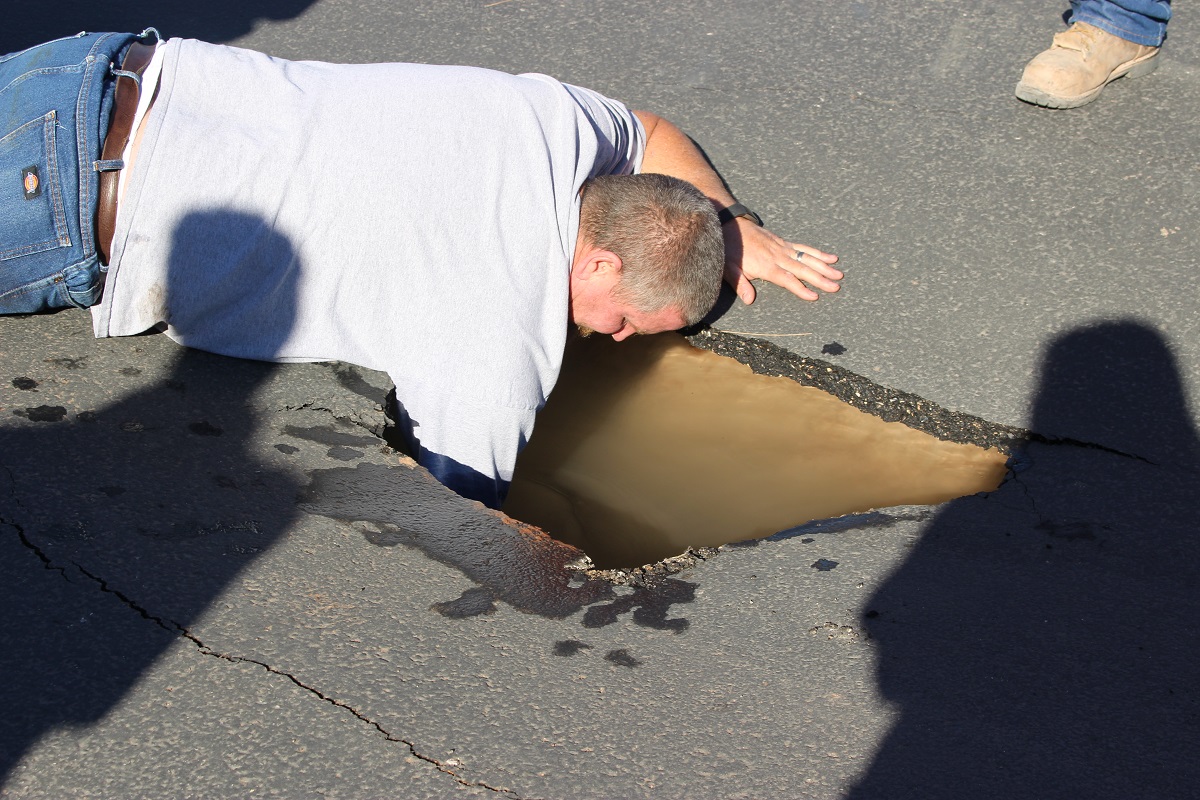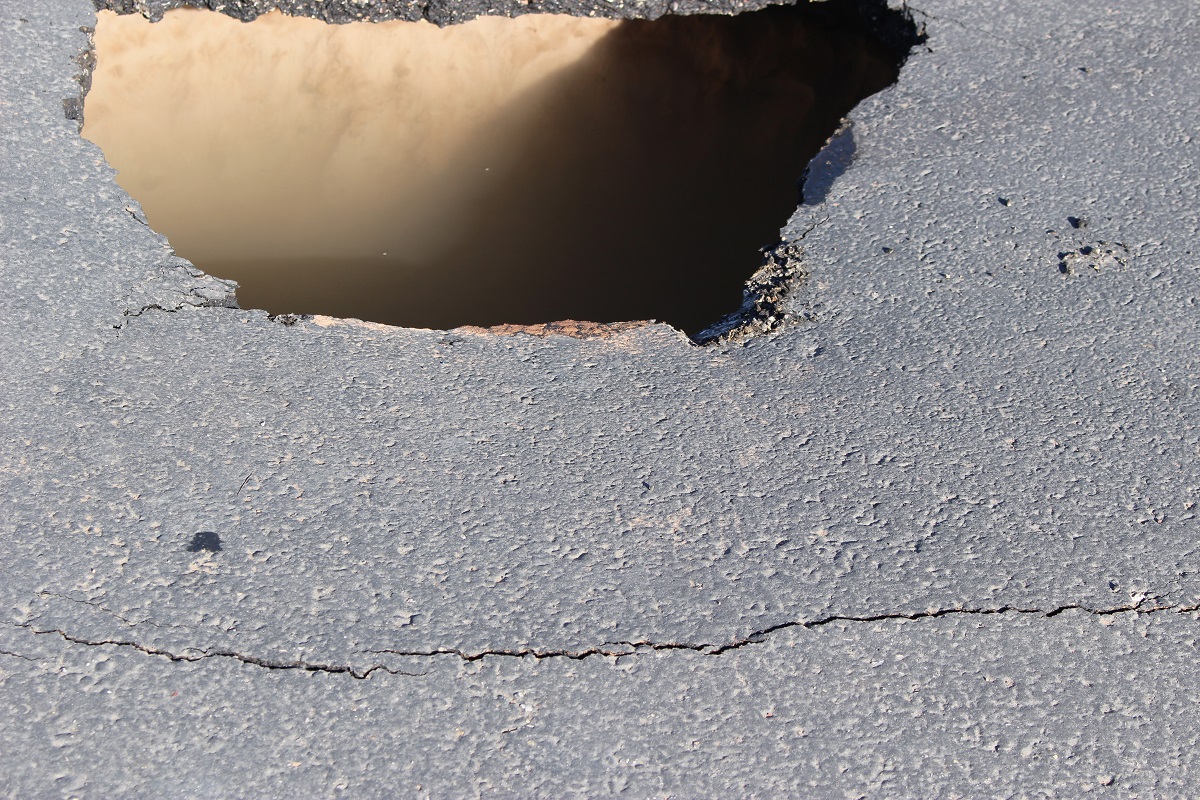WASHINGTON CITY — An exterminator making a routine service call at a residence in Washington City was startled Thursday afternoon to see her parked work truck drop into an sinkhole that suddenly opened up in the asphalt-covered roadway.

Shortly before 3:30 p.m. emergency personnel were dispatched to the reported sinkhole near 1543 N. 775 West in the Green Springs area of Washington City.
Washington Utilities Superintendent Michael Winters also arrived, along with an emergency crew, to assess the damage.
See the video in media player top of this report.
The sinkhole’s opening measured more than 2 feet in diameter while the growing cavern beneath it looked to be at least 4-5 feet deep as it was filling with water, Winters said.
Officers closed off a section of the street to prevent other motorists or residents from falling into the hole as emergency utility crews tended to the scene.
“The entire underground area that’s affected is very large,” Winters said, “because the water eroded a wide area underneath the road, and the underground damage goes beyond what can be seen from the surface.”
Southwest Exterminator owner Eric Palmer said one of his technicians arrived for an appointment and while speaking with the homeowner heard a loud noise out in the street.
“She heard a crash and looked over her shoulder and noticed that the service truck was sitting in a hole in the ground,” Palmer said, “so our truck was in the wrong place at the wrong time.”
Winters said the sinkhole was caused by erosion after an underground water line broke, filling the cavity surrounding the service line with water. Since the leak was underground with no sign of water near the surface it went unchecked until the weight of the service truck cracked the asphalt around it.
The service line is made from polyvinyl chloride, or PVC, pipe that was more than likely breached after a rock near the line rubbed against it. Over time that section of the pipe became thinner and thinner until it finally failed.
PVC piping is durable and easy to repair, making it the most commonly used material for water systems, underground wiring and sewer lines, according to information obtained from PVC.org.

“There are vibrations in the waterline that cause movement,” Winters said, “and even though it’s minimal it was enough to create friction between the rock and the line, which eventually caused it to fail.”
Water continued to flow out of that breach and filled the cavity surrounding the service line area which in turn eroded the foundation directly underneath the roadway.
“There’s no way of really knowing there’s a leak,” Winters said, “until today, when the man’s truck parked on top of the area and the weight of the truck caused the asphalt to sink and then break open, causing the hole.”
Normally a water leak is discovered before it has time to create the damage caused by erosion because it’s above ground and water can be seen as it surfaces, Winters added.
Utility workers routinely respond to this type of call, so while not all calls involve a sinkhole many of them do. Depending on the temperature, the weather and even the season, these types of calls tend to increase during the spring and fall.
“This problem is more common than most people think,” Winters said, “and is even more common in the Green Springs area.”
Emergency utility crews were on site to make the necessary repairs while water to the affected residence was temporarily shut off. The disruption of service was confined to that particular home, Winters said, as the break occurred in a portion of the line that ran directly into the residence while the main waterline remained operational.
The Southwest Exterminator’s service truck sustained damage during the incident and was towed from the scene. No injuries were reported.
According to the U.S. Geological Survey, sinkholes are common where the rock below the land surface is limestone, carbonate rock, salt beds or rocks that can naturally be dissolved by groundwater circulating through them.
Over time, spaces and caverns develop underground as the rock dissolves, but once the underground support is insufficient for the land above then the surface “roof’ sinks or collapses to form a hole.
For more information about the geology behind sinkholes visit USGS Water Science School – Sinkholes.
This report is based on preliminary information provided by responders and may not contain the full scope of findings.
Click on photo to enlarge it, then use your left-right arrow keys to cycle through the gallery.
Email: [email protected]
Twitter: @STGnews
Copyright St. George News, SaintGeorgeUtah.com LLC, 2017, all rights reserved.
A broken underground water line erodes soil and material that finally gives way as the asphalt first cracks and then crumbles under the weight of a service truck in Washington City, Utah, Mar. 2, 2017 | Photo by Cody Blowers, St. George News
A broken underground water line erodes soil and material that finally gives way as the asphalt first cracks and then crumbles under the weight of a service truck in Washington City, Utah, Mar. 2, 2017 | Photo by Cody Blowers, St. George News




I’m kind of curious about these things. If a water line breaks on the city side of the meter, or the main water line, and causes a sink hole on private property, just who is responsible for the damage?